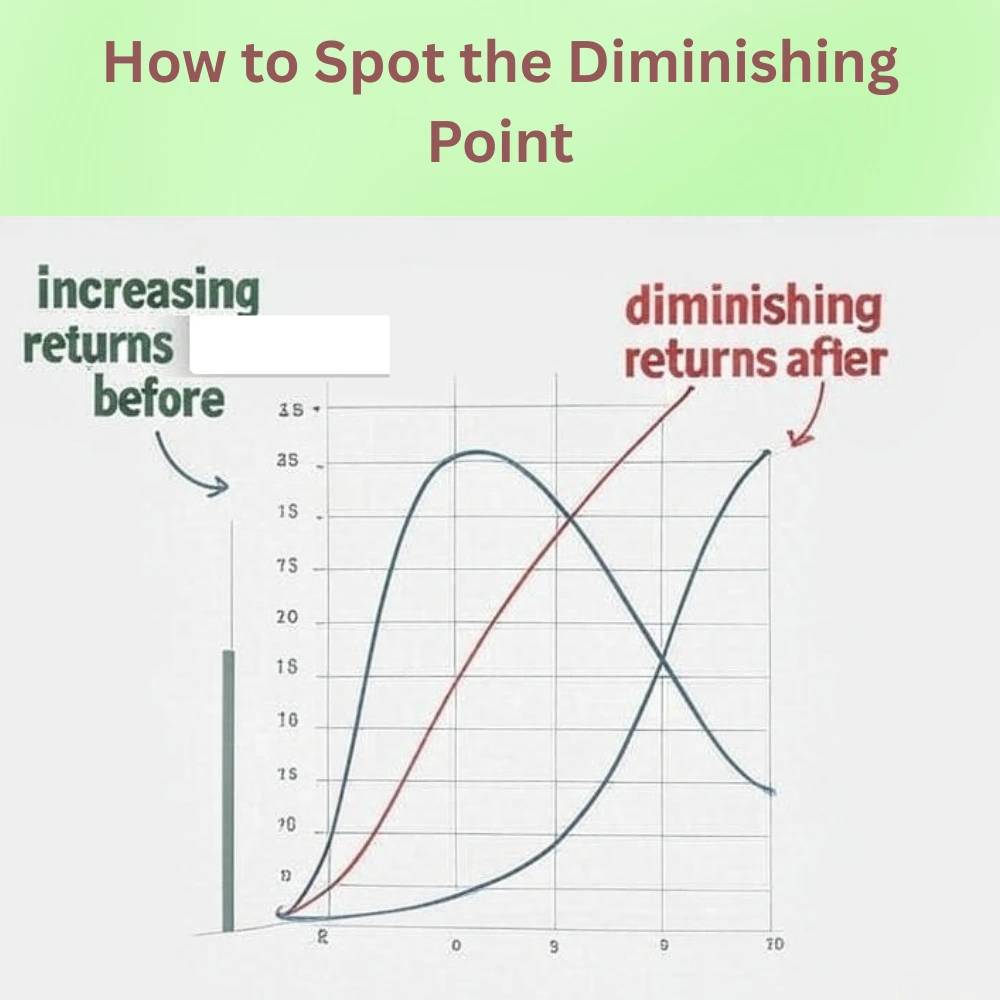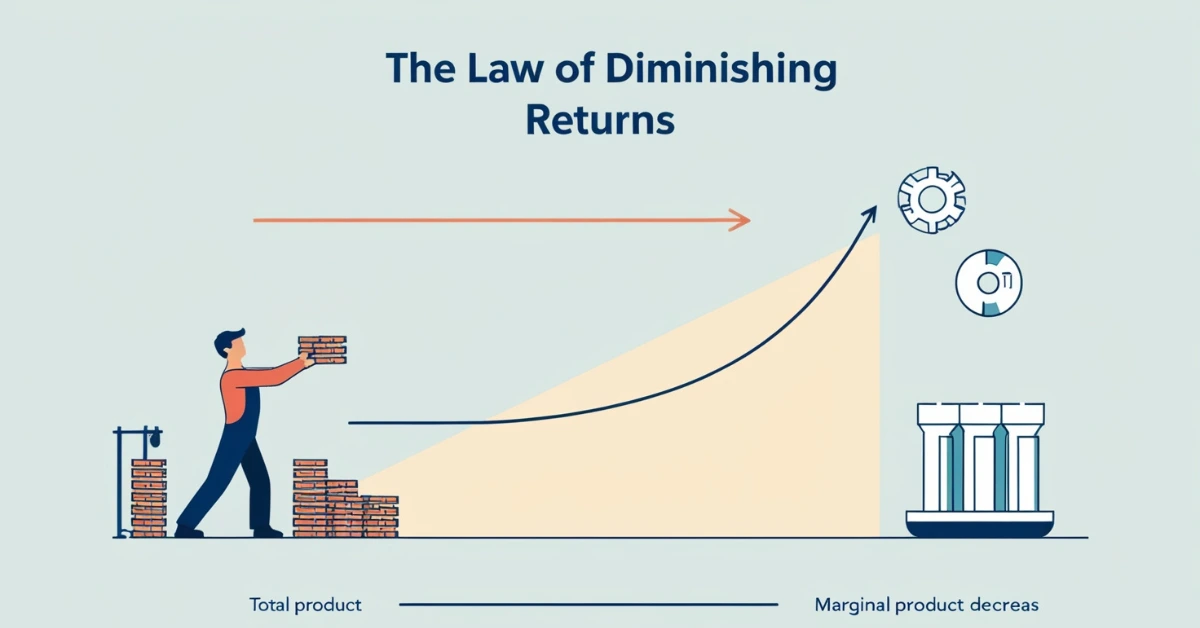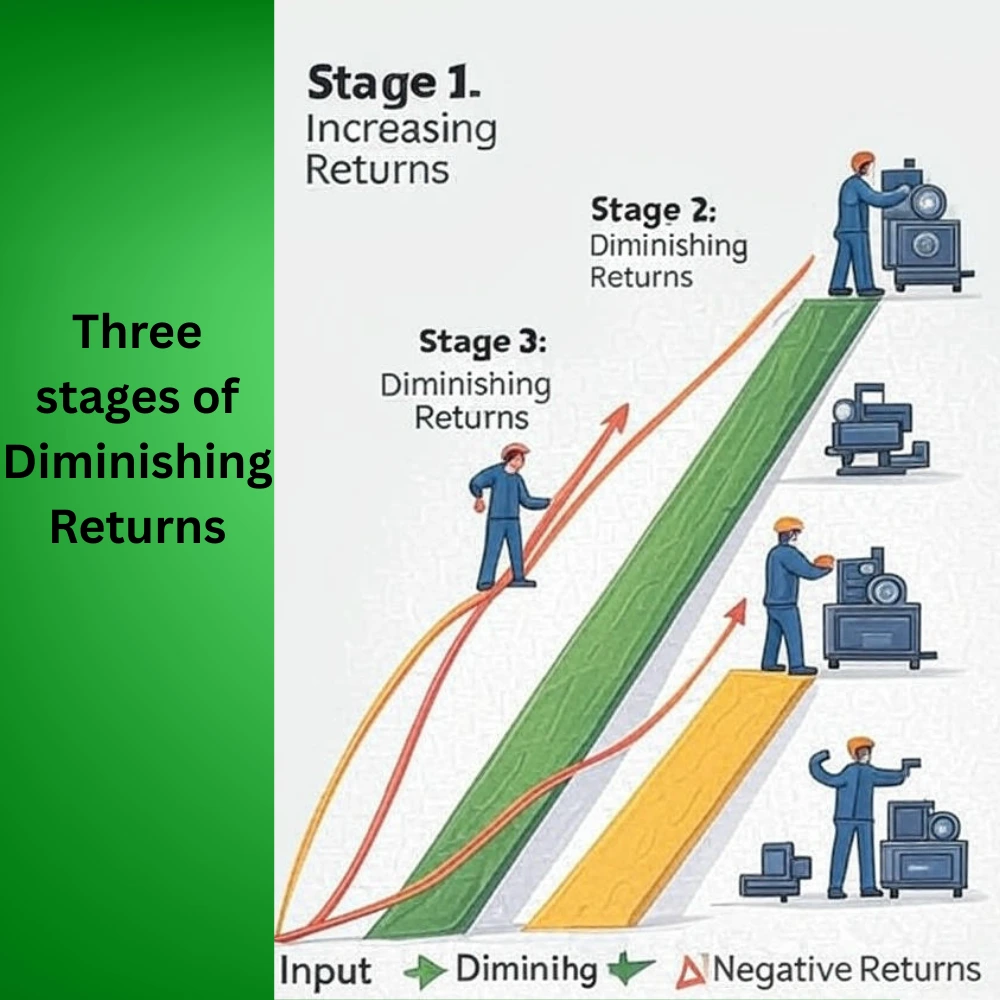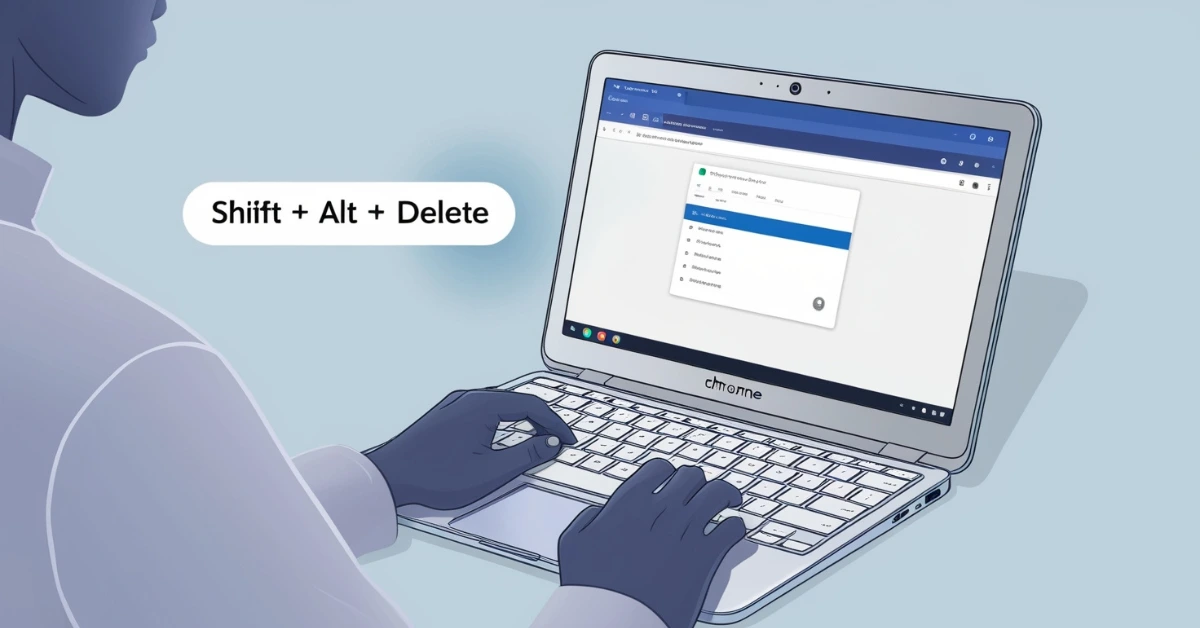The Law of Diminishing Returns is a basic but powerful idea in economics. It tells us that if we keep adding more of one input, like workers, fertilizer, or time while keeping other things the same. The extra benefit we get will eventually start to shrink.
What Is the Law All About?
Think about watering a plant. The first cup of water helps it grow. The second helps too, but not as much. By the fifth or sixth cup, the extra water doesn’t help at all and too much might even harm it. That’s the core idea of the law.
In economics, this happens when we keep increasing one input (like labor or material) while keeping another fixed (like machines or land). At first, the total output goes up quickly. Then it starts to rise slowly. After a point, each extra unit gives us less and less extra output. This is a clear example of how adding more input eventually leads to smaller gains in output.
Key Terms to Know
Here are some basic words used when talking about this law:
- Variable Input: Something you can increase or change, like the number of workers.
- Fixed Input: Something that stays the same for a while, like the size of a farm or factory.
- Total Product (TP): The total amount of output you get.
- Marginal Product (MP): The extra output you get by adding one more unit of input.
- Formula:
MP = Change in TP / Change in Input (like labor)
At the beginning, MP can rise because of better teamwork and use of resources. But soon it starts to fall because the fixed resources become too crowded or overused
To better understand the law of diminishing returns, it’s helpful to break down the production process into three distinct phases
Stage 1: Increasing Returns
- Every added input (e.g., an extra worker or machine) increases output significantly.
- The marginal Product (MP) rises.
This happens due to better resource utilization of workers specialize, machines run more efficiently, etc.
Example: The first two people in a bakery improve efficiency because one mixes while the other bakes.
Stage 2: Diminishing Returns
- This is where the law kicks in.
- MP starts to fall, but is still positive.
- Output still increases, but at a slower rate.
Example: The third or fourth baker helps, but now they occasionally wait for oven space so gains shrink.
Stage 3: Negative Returns
- Adding more input reduces total output.
- MP becomes zero or negative.
- Overcrowding, mismanagement, or resource exhaustion leads to inefficiency.
Example: A sixth person in a tiny bakery starts bumping into others, slowing everyone down.
Diminishing Returns vs Returns to Scale
These two ideas seem similar but are very different:
| Concept | Short run or Long run? | What’s Fixed? | What Happens? |
| Diminishing Returns | Short run | At least one input fixed | Output increases slowly, then drops |
| Returns to Scale | Long run | All inputs variable | Output changes with input ratio |
So, diminishing returns is about efficiency loss due to too much of one input, while returns to scale is about output change when everything is scaled up or down.
Graphical Explanation (Describe Without a Graph)
Even without a graph, you can imagine it:
- The Total Product (TP) curve rises fast at first
- Then it slows down (MP falls)
- Eventually, the curve flattens or even drops
The Marginal Product curve:
- Rises at first
- Peaks
- Then starts declining, crossing zero if negative returns happen
This is a perfect visual representation of the law, even if you’re just picturing it in your head.
A Simple Math View
Let’s look at a basic formula:
Q = f(L, K)
Where:
- Q is total output
- L is labor (which can change)
- K is capital (which stays fixed in the short run)
If we keep capital the same and keep adding labor, the extra output (MP) gets smaller after a point. That’s when the law kicks in.
To find marginal product of labor:
- MP<sub>L</sub> = Change in Q / Change in L
And when the second change becomes negative:
- Second change in Q / Second change in L < 0
This means the gains are slowing down.
Working Through the Numbers
To truly understand how the law of diminishing returns works, it helps to break it down using real numbers. This makes the theory practical and shows exactly how output changes as more input is added.
Let’s walk through a simple example using labor as the input and output as total product (TP)
Example Table
| Workers (Input) | Total Output (TP) | Marginal Product (MP) |
| 1 | 10 | 10 |
| 2 | 25 | 15 |
| 3 | 45 | 20 |
| 4 | 55 | 10 |
| 5 | 62 | 7 |
| 6 | 66 | 4 |
| 7 | 67 | 1 |
How to Read It?
- The Total Output increases with each new worker.
- But the Marginal Product (extra output from each new worker) does not increase consistently.
- It rises at first (from 10 to 20), but then starts falling (from 10 to 1).
- After the 3rd worker, each additional worker adds less and less to total output.
- By the 7th worker, the extra output is almost zero showing clear diminishing returns.
What This Tells Us?
- The first few units of labor are highly productive because they make good use of the fixed resources (like machines, space, etc.).
- After a certain point, the workspace becomes crowded or machines get overused.
- Output still grows, but much more slowly, and eventually adding more labor may not be worth the cost.
Real World Examples
This principle can be observed in many common real- ife situations, such as:
- manufacturing: when additional workers are assigned to a limited number of machines, it often results in congestion and reduced efficiency. As a result, the cost of producing each additional unit tends to rise.
- Call Centers: Hiring too many agents without upgrading hardware or bandwidth causes system lag and wasted labor time.
- Tech Teams: Throwing more developers at a late software project without adjusting workflow or tools often increases confusion and bugs, not output.
How to Spot the Diminishing Point?
You can use basic math to spot when returns begin to fall. If you have a return function (R), follow these steps:
- Take the first derivative to find when growth slows.
- Take the second derivative. If it’s negative, diminishing returns have begun.
Let’s say:
- R(x) = –2x³ + 24x² + 50
- 1st derivative: R′(x) = –6x² + 48x
- 2nd derivative: R″(x) = –12x + 48
Set the second derivative to zero to find the turning point:
- –12x + 48 = 0 → x = 4
- At x = 4, the gains begin to shrink.
Where Else Does This Apply Today?
The law of diminishing returns goes beyond farms and factories. It’s used in:
1. Tech & Software
- Hiring more programmers for a project that’s already behind schedule may actually slow things down because of extra communication and confusion.
- Extra features in an app might confuse users instead of adding value.
2. Digital Marketing
- First few ads convert well.
- Later ones cost more and reach fewer new users.
3. Diet & Fitness
- The first 30 minutes of exercise typically burn a significant amount of calories.
- Next 30 minutes burns less.
Too much? You risk injury or burnout.
4. Studying & Learning
- First few hours of studying help a lot.
- After a while, your brain retains less.
Eventually, you get mentally exhausted.
5. Quick Recap
The law says adding more of one input eventually gives smaller extra output.
- Marginal product rises first, then falls.
- This happens when at least one input is fixed.
- It’s seen in work, farming, study, and more.
Knowing this helps save money, time, and effort.
A Simple Analogy
Think about baking cookies. One person in the kitchen works well. Two help more. But ten people in a small kitchen? It’s chaos. They bump into each other, burn the cookies and slow things down. That’s diminishing returns.
Final Thoughts
The Law of Diminishing Returns is not just about economics. It teaches a life principle: more isn’t always better. Whether you’re running a business, managing a farm, or just trying to study smart, knowing when to stop adding more can make all the difference. It helps you work smarter not harder.




